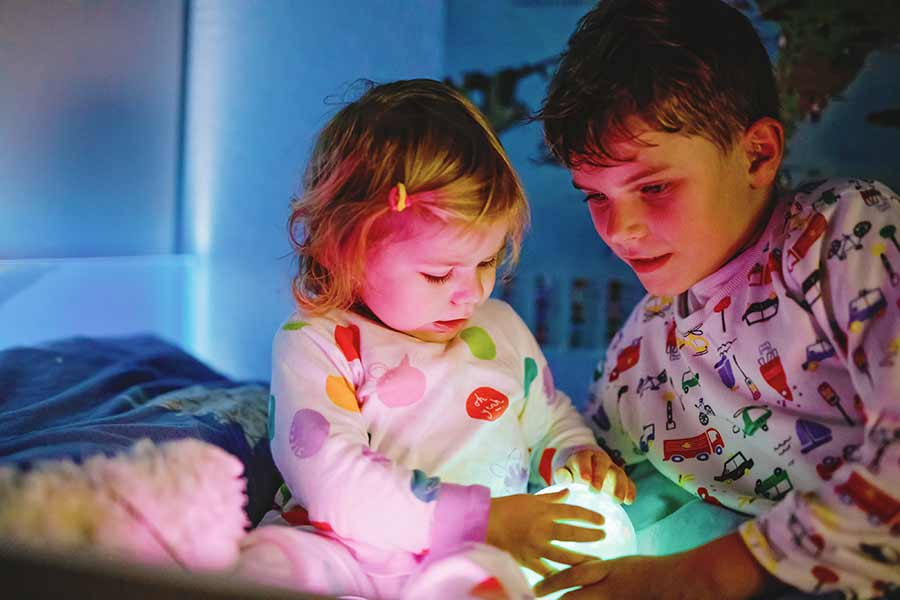The Power of Wavelength: How Light Affects Baby Sleep

As parents, we all know that sleep is crucial for our little ones’ development and well-being. Creating a conducive sleep environment for babies involves various factors, and one important element that often goes overlooked is the impact of light on their sleep patterns. Specifically, the wavelength of light has a significant influence on their sleep quality and overall sleep-wake cycle. In this article, we’ll explore how different wavelengths of light affect baby sleep and provide practical tips for optimizing their sleep environment.
Understanding Wavelengths of Light
Light consists of a spectrum of colors, each with its own wavelength. Wavelengths are measured in nanometers (nm), and different wavelengths have different effects on our bodies and sleep patterns. Two key types of light wavelengths that play a crucial role in baby sleep are blue light and red light.
Blue Light: Friend or Foe?
Blue light, which is present in sunlight and emitted by electronic devices such as smartphones, tablets, and televisions, has gained attention in recent years due to its potential negative effects on sleep. Exposure to blue light in the evening and at night can suppress the production of melatonin, a hormone that helps regulate sleep-wake cycles. This can disrupt the natural sleep pattern, making it difficult for babies to fall asleep and stay asleep.
Effects of Blue Light on Baby Sleep
Babies have more sensitive eyes than adults, and exposure to blue light before bedtime can interfere with their ability to fall asleep and stay asleep. Research suggests that blue light exposure can delay the onset of melatonin production, making it harder for babies to wind down and transition into a restful sleep state. Additionally, blue light exposure can lead to increased alertness, making it more challenging for babies to settle down for the night.
How to Create a Sleep-Friendly Environment
- Limit exposure to blue light: Avoid exposing your baby to electronic devices, including televisions and smartphones, at least one hour before bedtime. Consider using blue light filters or downloading applications that reduce the emission of blue light from electronic devices.
- Opt for warm-toned lighting: Use warm-toned or dim lights in the evening to create a soothing environment. This helps stimulate the production of melatonin, signaling to your baby’s body that it’s time to relax and prepare for sleep.
- Invest in blackout curtains: Blocking out external sources of light, such as streetlights or passing car headlights, can promote a dark and restful sleep environment for your little one.
The Gentle Influence of Red Light
Unlike blue light, red light has a longer wavelength and is less likely to disrupt the sleep-wake cycle. In fact, red light can be beneficial for baby sleep, as it does not interfere with melatonin production. Red light is often used in nightlights or special sleep lamps designed for nurseries, creating a warm and soothing environment that supports healthy sleep.
So, if blue light impedes your baby’s sleep, will red light actually improve it? To a large degree, the jury is still out on this debate. Some studies suggest that short-wavelength red light can indeed help stimulate melatonin production, but others have shown that exposure to red light, while much less inhibitive to sleep than blue light, resulted in similar or slightly less melatonin production than if the baby just slept in the dark. In essence, a red light in the nursery isn’t likely to help improve your little one’s sleep, assuming they’re already sleeping in a dark room. However, if you need a light in the nursery for diaper changes or nighttime feedings, red light is absolutely, positively the way to go.
To sum up, light plays a vital role in regulating baby sleep. By understanding the effects of different wavelengths, we can make informed decisions to create a sleep-friendly environment for our little ones. Limiting exposure to blue light and opting for red light when necessary can positively impact their sleep patterns and help establish healthy sleep habits from an early age. Remember, creating a peaceful sleep environment is an essential part of nurturing your baby’s overall well-being!
Source:
Figueiro MG, et al. (2011).The impact of light from computer monitors on melatonin levels in college students.
pubmed.ncbi.nlm.nih.gov/21552190/
Figueiro MG, et al. (2019). Effects of red light on sleep inertia.
ncbi.nlm.nih.gov/pmc/articles/PMC6506010/
Wright H. R., et al. (2004). Differential effects of light wavelength in phase advancing the melatonin. https://onlinelibrary.wiley.com/doi/abs/10.1046/j.1600-079X.2003.00108.x
– Sara




